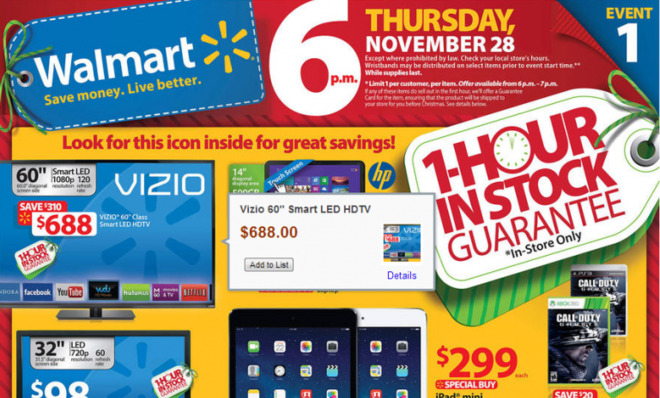Black Friday ads: 4 sneaky pricing tricks — and how to spot them
Consumers, beware


Unfortunately, for every door-buster steal on the first page of your favorite retailer's Black Friday ad scan, there are three ho-hum deals on the tenth page that aren't worth your time, money, or sleep. Black Friday has essentially cannibalized itself; retailers, in the rush to capture more and more dollars the day after Thanksgiving, have stuffed every product on hand into their Black Friday ads in the hopes that Black Friday's name will help them push "average" deals.
So what's a shopper to do? Peruse these ads carefully, for starters. Here are four of retailers' favorite Black Friday pricing tricks — and your best moves for beating them:
1. They mislead us on original prices. Retailers usually list the "regular" price of an item next to the Black Friday price to show shoppers the discount they're getting on a Black Friday purchase.
The Week
Escape your echo chamber. Get the facts behind the news, plus analysis from multiple perspectives.

Sign up for The Week's Free Newsletters
From our morning news briefing to a weekly Good News Newsletter, get the best of The Week delivered directly to your inbox.
From our morning news briefing to a weekly Good News Newsletter, get the best of The Week delivered directly to your inbox.
To make the discount appear larger, though, retailers typically use the original item's manufacturer's suggested retail price (MSRP) as the "regular" price in the ad, not the price the item is currently selling for on their website. In Bon-Ton's 2013 Black Friday ad scan, for example, the retailer advertises a $99.97 price for the Keurig K45 Elite Brewer, down from the regular $172, according to Bon-Ton.
If you checked out Bon-Ton's website at the time of this writing, though, you'd find that same Keurig K45 coffee brewer selling currently for $119.99. Bon-Ton's Black Friday Keurig K45 price isn't a bad one — but it isn't exactly $72 off.
This practice isn't limited to Bon-Ton. Macy's 2013 Black Friday ad shows a Tommy Hilfiger faux leather military bomber jacket, WebId #947625, selling for the Black Friday price of $79.99, down from the regular price of $195-$250. If you search for the item on Macy's online store, though, you'd find the same Tommy Hilfiger leather jacket, with the same web id, selling for the same $79.99 price.
These deals aren't exactly buried in the ads, either — both the Bon-Ton and Macy's examples are from the retailers' first pages of their 2013 ads.
A free daily email with the biggest news stories of the day – and the best features from TheWeek.com
How to beat the retailer: Double check the "regular" price of an item to make sure you're getting the deal you think you're getting.
2. They push derivative products. How can retailers offer such eye-popping discounts on HDTVs, laptops, and other electronics? Well, the wares they're selling often aren't the cream of the crop. While some retailers simply sell lower-end brands, other less forthcoming merchants hawk limited-time-only TV models designed for the holiday season and Black Friday.
These models are, unsurprisingly, unreliable and shoddy. Derivative products often have fewer features than comparable sets as well.
How to beat the retailer: Check the model numbers you see in Black Friday ads against the retailer's current website offering or in a standard web search engine. If you can't find that specific TV currently on sale at multiple retailers, you might be looking at a derivative product.
3. They repeat deals from last year. While many deals advertised in Black Friday ad leaks aren't exclusive to the holiday, some of these sales aren't even exclusive to Black Friday 2013. A NerdWallet study last year found that 90 percent of Black Friday ads from 2012 contained at least one of the exact same items selling at the exact same price as in 2011.
For shoppers purchasing discounted Christmas trees or cheap cookware, this deal repetition might not be a problem. For consumers purchasing consumer technology, though, this sneaky retailer practice is a raw deal.
Staples, for example, sold the same Brother MFC-7860DW Laser Multi-Function Wireless Printer for $199.99 in both 2011 and 2012. You'd expect another year of the printer product cycle to have further outdated that wireless printer — but the printer wasn't any cheaper at Staples in 2012.
How to beat the retailer: Compare a retailer's 2013 Black Friday ad scan side-by-side with the retailer's 2012 edition. If any items have very similar product pictures, take a closer look — there's a good chance you'll find it's the same item, selling at the exact same price.
4. They use rebates. Rebates are a tried-and-true Black Friday tactic. Merchants will advertise a fantastic item price in their ads and then sneak a line of fine print under the item stating that shoppers will need to submit a rebate to get that advertised price.
How painful the rebate process is varies significantly by retailer — but remember that you'll probably have a lot on your mind during the holidays. Shoppers often forget to submit rebates — which is exactly why retailers love them.
How to beat the retailer: Watching out for rebates is fairly simple — make sure to read every ounce of text in your desired item's item description box. Better yet, read the whole page: There might be fine print at the bottom of the ad. Then be sure to claim the rebate to which you're entitled.
More from The Fiscal Times...
-
 Biggest political break-ups and make-ups of 2025
Biggest political break-ups and make-ups of 2025The Explainer From Trump and Musk to the UK and the EU, Christmas wouldn’t be Christmas without a round-up of the year’s relationship drama
-
 Why 2025 was a pivotal year for AI
Why 2025 was a pivotal year for AITalking Point The ‘hype’ and ‘hopes’ around artificial intelligence are ‘like nothing the world has seen before’
-
 The best drama TV series of 2025
The best drama TV series of 2025the week recommends From the horrors of death to the hive-mind apocalypse, TV is far from out of great ideas